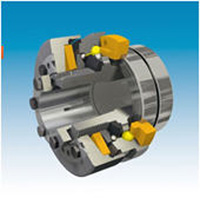Torque limiting clutches for high-speed applications in test stands

EAS-HSC clutches transmit the torque backlash-free during operation, and allow the drive components to slow down freely on overload. <br>
In addition, the installation spaces available are becoming increasingly small due to the increasingly compact constructions. Mayr power transmission has therefore developed the new torque limiting clutch EAS-HSC (High-Speed-Compact) for speeds of up to 12,000 rpm.
In test stand technology, torque limiting clutches must be capable of transmitting the torque backlash-free and with torsional rigidity at extremely high speeds. The only devices suitable for this purpose are residual torque-free or disengaging torque limiting clutches, which allow the stored rotational energy in coupled masses to slow down freely.
Torque limiting clutches in high-speed applications must have a high balance quality in every individual component, so that optimum running smoothness of the drive train is guaranteed in combination with the components. Therefore, the optimisation of the mass unbalance was one of the highest priorities in the technical specifications.
In addition to their extremely compact construction, a high performance density reduces the rotating masses, which has a positive effect on running smoothness and machine dynamics. The clutch is balanced in completely assembled condition to a balance quality of G 2.5 at a reference speed of 3000 rpm.
If the torque in the drive line exceeds the limit value set on the EAS-HSC, the clutch disengages via a unique disengagement mechanism. This holds it securely in disengaged position. The torque drops immediately and an installed limit switch detects the disengagement movement and switches off the drive.
The limit switch signal can also be used for further control functions. The clutch separates the input and output completely and remains in this condition until it is re-engaged by hand or using a device.
In normal operation, the torque on the EAS-HSC is transmitted using balls which engage simultaneously with the hub and drive flange grooves. Cup springs clamp the balls via a ring. The level of the spring force is proportional to the transmittable torque. This principle also remains backlash-free when the grooves wear down, as the cup springs have a falling characteristic curve. Therefore, the torque is transmitted with torsional rigidity up to the pre-set trigger value. In case of overload, the pre-tension force of the spring and the clutch trigger highly accurately.
The clutches transmit the torque backlash-free during operation, and ensure that the drive components slow down freely on overload. During the overtravel time, no engagement impacts occur which might have a negative effect on the drive line. Re-engagement takes place “synchronously” only at the disengagement position. This is frequently required if the input and output always have to have the same angular position to each other.
With its five construction sizes, the EAS-HSC provides nominal torques from 5 to 1000 Nm. Depending on the size, speeds from 6000 to 12,000 rpm are permitted.
Contact:
Chr. Mayr GmbH + Co. KG, Eichenstraße 1, 87665 Mauerstetten, Dipl.-Ing. (FH) Hermann Bestle
Tel.: 08341/804-232, Fax: 08341/804-49232
E-Mail: hermann.bestle@mayr.de, Web: http://www.mayr.com
Media Contact
More Information:
http://www.mayr.comAll latest news from the category: Machine Engineering
Machine engineering is one of Germany’s key industries. The importance of this segment has led to the creation of new university degree programs in fields such as production and logistics, process engineering, vehicle/automotive engineering, production engineering and aerospace engineering among others.
innovations-report offers informative reports and articles covering technologies such as automation, motion, power train, energy, conveyor, plastics, lightweight construction, logistics/warehousing, measurement systems, machine tools and control engineering.
Newest articles

Properties of new materials for microchips
… can now be measured well. Reseachers of Delft University of Technology demonstrated measuring performance properties of ultrathin silicon membranes. Making ever smaller and more powerful chips requires new ultrathin…

Floating solar’s potential
… to support sustainable development by addressing climate, water, and energy goals holistically. A new study published this week in Nature Energy raises the potential for floating solar photovoltaics (FPV)…

Skyrmions move at record speeds
… a step towards the computing of the future. An international research team led by scientists from the CNRS1 has discovered that the magnetic nanobubbles2 known as skyrmions can be…





















